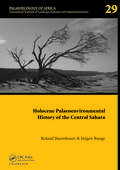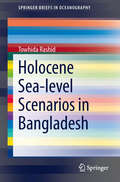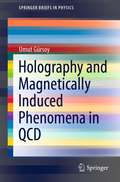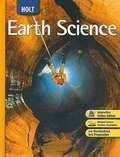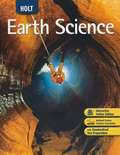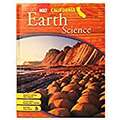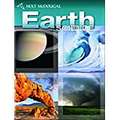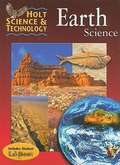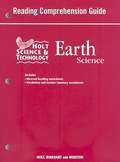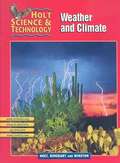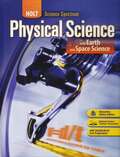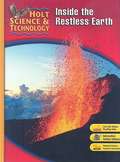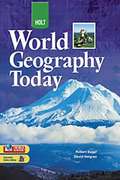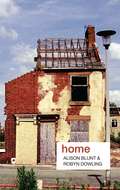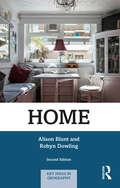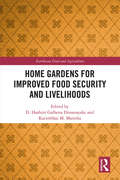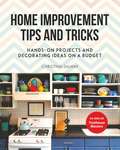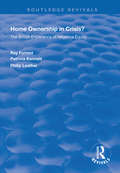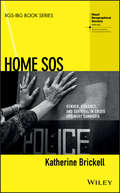- Table View
- List View
Holocene Palaeoenvironmental History of the Central Sahara: Palaeoecology of Africa Vol. 29, An International Yearbook of Landscape Evolution and Palaeoenvironments (Palaeoecology of Africa)
by Jürgen Runge Roland BaumhauerThe environmental setting within the Central Sahara was subject to considerable changes during Late Quaternary, mainly driven by major global climate variations, although human impact increased constantly since Early Holocene.Such global events can be reconstructed with the help of reliefs, sediments and palaeosoils and their specific morphological
Holocene Sea-level Scenarios in Bangladesh
by Towhida RashidThis Brief deals with the reconstruction of Holocene paleoenvironment in the central part of Bangladesh in relation to relative sea-level (RSL) changes which is 200 km north from the present coastline. Lithofacies characteristics, mangal peat, diatom and paleophysiographical evidences were considered to reconstruct the past position and C-14 ages were used to determine the time of formation of the relative sea-level during the Holocene. With standard reference datum the required m. s. l. at the surface of five sections are calculate and the RSL curve suggests that Bangladesh has experienced two mid Holocene RSL transgressions punctuated by regressions. The abundant marine diatom and mangrove pollens indicates that the highest RSL transgression in Bangladesh is around 6000 cal BP which is attained at least 4. 5 to 5m higher than the modern m. s. l. After this phase, the relative sea-level started to fall and consequently a freshwater peat developed around 59805700 cal BP. The abundant mangrove pollens in salt-marsh succession shows the regression around 5500 cal BP and, the height was 12 m higher than the modern sea level. These and more interesting findings are discussed in this Brief.
Holography and Magnetically Induced Phenomena in QCD (SpringerBriefs in Physics)
by Umut GürsoyThis book introduces the traditional and novel techniques required to study the thermodynamic and transport properties of quark–gluon plasma. In particular, it reviews the construction of improved holographic models for QCD-like confining gauge theories and their applications in the physics of quark–gluon plasma. It also discusses the recent advances in the development of hydrodynamic techniques, especially those incorporating the effects of external magnetic fields on transport. The book is primarily intended for researchers and graduate students with a background in quantum field theory and particle physics but who may not be familiar with the theory of strong interactions and holographic and hydrodynamic techniques required to study said interactions.
Holt Earth Science
by Jay M. Pasachoff Mead A. Allison Arthur T. DegatetanoThis text book on Earth Science contains unit lessons on Studying the Earth, Composition of the Earth, History of the Earth, The Dynamic Earth, Reshaping the Crust, Oceans, Atmospheric Forces and Space. Chapter Labs, Quick Labs, Maps in Action, Feature Articles are some of the additional features.
Holt Earth Science (California Edition)
by Holt Rinehart Winston StaffHolt Science California Grade 6 Earth organizes knowledge on the world we live in. Each chapter involves the learners taking them step by step through the exploration of science
Holt Mcdougal Earth Science
by Holt Mcdougal Allison Holt McDougalHolt Mcdougal Earth Science: Student Edition 2010
Holt Science & Technology: Earth Science
by Holt Rinehart WinstonThis book on Earth Science contains unit lessons of Introduction to Earth Science, Earth's Resources, The Restless Earth, Reshaping the Land, Oceanography, Weather and Climate, etc.
Holt Science & Technology: Earth Science, Reading Comprehension Guide
by Rinehart Winston Staff HoltNIMAC-sourced textbook
Holt Science & Technology: The Earth's Surface
by Holt Rinehart Winston Staff7th grade science textbook
Holt Science And Technology: Weather and Climate
by Holt Rinehart Winston StaffMiddle School Science
Holt Science Spectrum®: Physical Science with Earth and Space Science
by Ken Dobson John Holman Michael RobertsNIMAC-sourced textbook
Holt Science and Technology: Earth Science Reading Comprehension Guide
by Holt Rinehart Winston StaffHolt Science And Technology Earth Science: Reading Comprehension Guide
Holt Science and Technology: Inside the Restless Earth
by Holt Rinehart WinstonScience is a process of discovery, a trek into the unknown. The skills you develop using Holt Science & Technology--such as observing, explaining observations and ideas--are the skill you will need for the future. There is a universe of exploration and discovery awaiting those who accept the challenges of science.
Holt Science and Technology: Inside the Restless Earth
by Holt Rinehart WinstonLearn all you can about the inside of the earth in this book. Topics include: volcanoes, plate tectonics, minerals, rocks and fossil.
Holt World Geography Today
by Robert J. Sager David M. HelgrenThis geography textbook helps students make connections between what they learn in class and real events around the world today.
Holt World Geography Today (Texas Edition)
by Robert J. Sager David M. HelgrenDo you know why the loss of huge forest areas in one part of the world can affect areas far away? Why does the United States have many different kinds of churches and other places of worship? Perhaps you are curious why Americans and people from other countries have such different points of view on many issues. The key to understanding questions and issues like these lies in the study of geography.
Home (Key Ideas in Geography)
by Alison Blunt Robyn Dowling‘Home’ is a significant geographical and social concept. It is not only a three-dimensional structure, a shelter, but it is also a matrix of social relations and has wide symbolic and ideological meanings; home can be feelings of belonging or of alienation; feelings of home can be stretched across the world, connected to a nation or attached to a house; the spaces and imaginaries of home are central to the construction of people’s identities. An essential guide to studying home and domesticity, this book locates ‘home’ within wider traditions of thought. It analyzes different sources, methods and examples in both historical and contemporary contexts; ranging from homes on the American frontier and imperial domesticity in British India, to Australian suburbs, multicultural London, and South Asian diasporic homes. The core argument of the book has three main parts that cut across each of its chapters: home-making identity and belonging homely and unhomely spaces. Each chapter includes text boxes and exercises and is well illustrated with cartoons, line drawings, and photographs. Outlining the social relations shaping, (and being influenced by) the geographies of home; and the imaginative as well as material importance of home, this book will be a valuable reference for students of geography, sociology, gender studies, and those interested in the home and domesticity.
Home (Key Ideas in Geography)
by Alison Blunt Robyn DowlingHome articulates a ‘critical geography of home’ in which home is understood as an emotive place and spatial imaginary that encompasses lived experiences of everyday, domestic life alongside a wider, and often contested, sense of being and belonging in the world. Engaging with the burgeoning cross-disciplinary interest in home since the first edition was published, this significantly revised and updated second edition contains new research boxes, illustrations, and contemporary examples throughout. It also adds a new chapter on ‘Home and the City’ that extends the scalar understanding of home to the urban. The book develops the conceptual and methodological underpinnings of a critical geography of home, drawing on key feminist, postcolonial, and housing thinkers as well as contemporary methodological currents in non-representational thinking and performance. The book’s chapters consider the making and unmaking of home across the domestic scale – house-as-home; the urban – city-as-home; national – nation-as-home; and homemaking in relation to transnational migration and diaspora. Each chapter includes illustrative examples from diverse geographical contexts and historical time periods. Chapters also address some of the key cross-cutting dimensions of home across these scales, including digital connectivity, art and performance, more-than-human constructions of home, and violence and dispossession. The book ends with a research agenda for home in a world of COVID-19. The book provides an understanding of home that has three intersecting dimensions: that material and imaginative geographies of home are closely intertwined; that home, power, and identity are intimately linked; and that geographies of home are multi-scalar. This framework, the examples used to illustrate it, and the intended audience of academics and students across the humanities and social sciences will together shape the field of home studies into the future.
Home Gardens for Improved Food Security and Livelihoods (Earthscan Food and Agriculture)
by D. Hashini Galhena Dissanayake Karimbhai M. MarediaHome Gardens for Improved Food Security and Livelihoods demonstrates how home gardens hold particular significance for resource-poor and marginalized communities in developing countries, and how they offer a versatile strategy toward building local and more resilient food systems.With food and nutritional security being a major global challenge, there is an urgent need to find innovative ways to increase food production and diversify food sources while increasing income-generating opportunities for communities faced with hunger and poverty. This book shows that when implemented properly, home gardens can become just such an innovative solution, as well as an integral part of sustainable food security programs. It provides a conceptual overview of social, economic, environmental and nutritional issues related to home gardening in diverse contexts, including gender issues and biodiversity conservation, and presents case studies from Africa, Asia and Latin America highlighting home gardening experiences and initiatives. The volume concludes with a synthesis of key lessons learned and ways forward for further enhancing home gardens for sustainable food security and development.This book will be a useful read for students and scholars working on local food systems, food security, sustainable development and more broadly development strategy.
Home Improvement Tips and Tricks: Hands-on Projects and Decorating Ideas on a Budget
by Christina SalwayStep-by-Step Projects from a Successful and Sassy Interior Designer!Searching for a house or apartment is difficult enough on its own; transforming it into your home is an entirely different story. Home Improvement Tips and Tricks aims to give you the knowhow to decorate while staying within your budget, all presented in an engaging and approachable way. Each project is accompanied by a list of tools and materials needed, along with step-by-step instructions. Salway’s wit and playful personality shine through as she shares her tried-and-true advice to describe the journey of renovating and redecorating not only her two-bedroom Williamsburg apartment but also the upstate New York farmhouse bought as a major fixer-upper. Some of Christina’s greatest lessons include: Colors you shouldn’t paint your apartment, even if you like wearing them Where to look, when to haggle, and how to spot a diamond in the rough How to revitalize your kitchen on a budget Your shower curtain shouldn’t reflect your personality, and other helpful bathroom hints How to install a dimmer switch (a.k.a. instant mood lighting) A resource for anyone who is short on time and strapped for cash, Home Improvement Tips and Tricks will help you turn any space into a unique home you love and are proud to show off.
Home Ownership in Crisis?: The British Experience of Negative Equity (Routledge Revivals)
by Ray Forrest Patricia Kennett Philip LeatherFirst published in 1999, this book brings together the findings from research projects funded by the Joseph Rowntree Foundation and the Department of the Environment, Transport and the Regions. The programme of research examined the problems faced by home owners with the collapse of the property market in the late 1980s. The book focuses on households with negative equity and uses analyzes of secondary data sets, social surveys and in-depth interviews to explore the implications of the fall in property values for both households and the wider economy. In particular it examines the kinds of coping strategies adopted by home owners in relation to debt and mobility. Home Ownership in Crisis? thus gets beyond aggregate estimates and offers the reader a detailed understanding of what negative equity actually means for the individuals concerned. Moreover, by exposing a range of circumstances in which negative equity arises, the book also informs debates about the kinds of policy initiatives which may be appropriate in dealing with a more volatile economic environment in Britain and elsewhere.
Home SOS: Gender, Violence, and Survival in Crisis Ordinary Cambodia (RGS-IBG Book Series)
by Katherine BrickellDrawing on 15 years of fieldwork and over 300 interviews, Home SOS argues that the home is central to the violence and gendered contingency of existence in crisis ordinary Cambodia. Provides an original book-length study which brings domestic violence and forced eviction into twin view Offers relational insights between different violences to build an integrated understanding of women’s experiences of home life Mobilises the crisis ordinary as a critical pedagogy and imaginary through which to understand everyday gendered politics of survival Positions domestic violence and forced eviction as manifestations of intimate war against women’s homes and bodies located inside and outside of the traditional purview of war Reaffirms and reprioritises the home as a political entity which is foundational to the concerns of human geography
